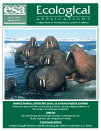 Professor Gagnon is this week’s #RacerScholar for contributing to the article, “How livestock and flooding mediate the ecological integrity of working forests in Amazon River floodplains,” in the January 2016 edition of Ecological Applications.
Professor Gagnon is this week’s #RacerScholar for contributing to the article, “How livestock and flooding mediate the ecological integrity of working forests in Amazon River floodplains,” in the January 2016 edition of Ecological Applications.
Abstract:
The contribution of working forests to tropical conservation and
development depends upon the maintenance of ecological integrity under
ongoing land use. Assessment of ecological integrity requires an
understanding of the structure, composition, and function and major
drivers that govern their variability. Working forests in tropical river
floodplains provide many goods and services, yet the data on the
ecological processes that sustain these services is scant. In flooded
forests of riverside Amazonian communities, we established 46 0.1-ha
plots varying in flood duration, use by cattle and water buffalo, and
time since agricultural abandonment (30-90 yr). We monitored three
aspects of ecological integrity (stand structure, species composition,
and dynamics of trees and seedlings) to evaluate the impacts of
different trajectories of livestock activity (alleviation, stasis, and
intensification) over nine years. Negative effects of livestock
intensification were solely evident in the forest understory, and plots
alleviated from past heavy disturbance increased in seedling density but
had higher abundance of thorny species than plots maintaining low
activity. Stand structure, dynamics, and tree species composition were
strongly influenced by the natural pulse of seasonal floods, such that
the defining characteristics of integrity were dependent upon flood
duration (3-200 d). Forests with prolonged floods >= 140 d had not only
lower species richness but also lower rates of recruitment and species
turnover relative to forests with short floods < 70 d. Overall, the
combined effects of livestock intensification and prolonged flooding
hindered forest regeneration, but overall forest integrity was largely
related to the hydrological regime and age. Given this disjunction
between factors mediating canopy and understory integrity, we present a
subset of metrics for regeneration and recruitment to distinguish forest
condition by livestock trajectory. Although our study design includes
confounded factors that preclude a definitive assessment of the major
drivers of ecological change, we provide much-needed data on the
regrowth of a critical but poorly studied ecosystem. In addition to its
emphasis on the dynamics of tropical wetland forests undergoing
anthropogenic and environmental change, our case study is an important
example for how to assess of ecological integrity in working forests of
tropical ecosystems.
 How livestock and flooding mediate the ecological integrity of working forests in Amazon River floodplains
How livestock and flooding mediate the ecological integrity of working forests in Amazon River floodplains
By Christine M. Lucas, Pervaze Sheikh, Paul R. Gagnon and David G. McGrath
Ecological Applications: Jan 2016, vol. 26 (1), pgs. 190-202
DOI: 10.1890/14-2182